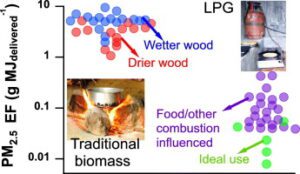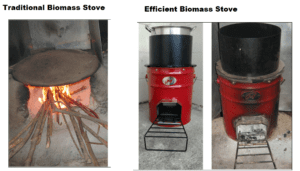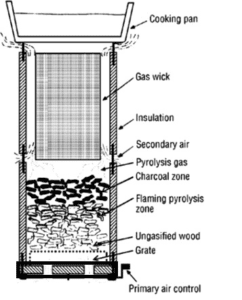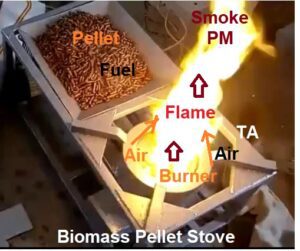Introduction to Biomass Burning
- Biomass stoves have been a primary source of cooking and heating for billions of people around the world for centuries.
- They rely on organic materials such as wood, crop residues, and animal dung as fuel.
- While these stoves are essential for daily life in many communities, they also come with significant environmental and health challenges.
- Emissions from traditional biomass stoves contribute to indoor and outdoor air pollution, which can lead to serious health problems and environmental degradation.
- However, by implementing effective control measures, we can reduce emissions and mitigate these harmful impacts.

Understanding the Problem in Tradition Stoves
Biomass stove cooking can produce various types of pollution, both indoors and outdoors. These pollutants can have adverse effects on both human health and the environment. Here are the primary types of pollution associated with biomass stove cooking:
Indoor Air Pollution:
- Traditional biomass stoves often lack proper ventilation, leading to the accumulation of harmful pollutants indoors.
- Prolonged exposure to indoor air pollution can result in respiratory diseases, especially among women and children who spend more time in proximity to the stove.
- Poorly ventilated cooking areas can lead to high levels of indoor air pollution.
- This can result in respiratory diseases, eye irritation, and other health problems, especially among women and children who spend more time in close proximity to the stove.
- The traditional biomass produces a lot of emissions.

Respiratory Health Problems:
- Prolonged exposure to indoor air pollution from biomass burning is associated with various respiratory health problems, including chronic obstructive pulmonary disease (COPD), pneumonia, and lung cancer.
Eye and Skin Irritation:
- The pollutants released during biomass burning can irritate the eyes and skin, leading to discomfort and health issues.
Increased Vulnerability:
- Women and children, who often spend more time near the stove while cooking, are particularly vulnerable to the health effects of indoor air pollution from biomass burning.
Long-term Health Effects and Mortality
- Chronic exposure to indoor air pollution from biomass burning can have long-term health consequences, including reduced lung function and an increased risk of respiratory and cardiovascular diseases.
- Indoor air pollution from biomass burning is estimated to contribute to a significant number of premature deaths worldwide, particularly in regions where traditional stoves are prevalent.

Pollution from Biomass Stove Cooking
Biomass stoves release a variety of pollutants during combustion, including particulate matter (PM), carbon monoxide (CO), volatile organic compounds (VOCs), and greenhouse gases like methane (CH4). These emissions pose several critical issues:
Particulate Matter (PM)
- Particulate matter consists of tiny airborne particles, including dust, soot, and ash.
- Burning biomass can release fine PM into the air, which can be inhaled deep into the lungs.
- Exposure to PM is linked to respiratory problems, cardiovascular diseases, and even premature death.

Carbon Monoxide (CO):
- Carbon monoxide is a colorless, odorless gas produced during incomplete combustion of biomass.
- Breathing in high levels of CO can lead to headaches, dizziness, nausea, and even death in extreme cases, especially in poorly ventilated cooking areas.
Volatile Organic Compounds (VOCs):
- VOCs are organic chemicals that can evaporate into the air during biomass combustion.
- Some VOCs can contribute to the formation of ground-level ozone and smog, which can harm respiratory health and the environment.
Methane (CH4):
- Methane is a potent greenhouse gas emitted during biomass burning.
- It contributes to climate change by trapping heat in the atmosphere.
- While not a direct health concern indoors, it has significant environmental impacts.
Polycyclic Aromatic Hydrocarbons (PAHs):
- PAHs are a group of toxic chemicals formed during incomplete combustion of organic materials like wood.
- They can adhere to particulate matter and be inhaled or deposited onto surfaces. Some PAHs are known carcinogens.
Nitrogen Oxides (NOx):
- Biomass combustion can produce nitrogen oxides, which contribute to air pollution and can lead to respiratory issues.
- They also play a role in the formation of acid rain.

Techniques to Control Biomass Emissions
- Controlling emissions from biomass burning is essential to reduce the environmental and health impacts associated with this practice.
- Biomass burning includes activities such as wood and crop residue burning, which release pollutants into the atmosphere.
- Here are some effective strategies and techniques for controlling emissions from biomass burning:
Switch to Cleaner Fuels:
- One of the most effective ways to reduce emissions from biomass burning is to switch to cleaner fuels such as natural gas, propane, or electricity.
- These alternatives produce fewer pollutants and are often more efficient.
Improved Combustion Technology
- Upgrade traditional biomass stoves and burners with advanced combustion technologies, like gasification and pyrolysis.
- These technologies can improve combustion efficiency and reduce emissions significantly.
- Gasification of biomass fuels can lead to efficient and clean combustion. The Gasification technology is the way to reduce the pollution from biomass burning as shown in the post of CFD Flow Engineering.

Standard for Certifications of Biomass Stoves
- Check the combustion efficiency and formation of pollutants formed in the stoves as per the post.
- High moisture or poor-quality biomass results in high incomplete combustion and particulate matter.
Use of Biomass Briquettes or Pellets:
- Biomass briquettes and pellets are densified forms of biomass that burn more efficiently and produce fewer emissions than loose biomass as per the post.
- They can be used in specially designed-biomass stoves and boilers.
- Biomass pellets contain low moisture and their heating value is improved by adding charcoal.

Implement Emission Control Devices:
- Install emission control devices like particulate matter filters and scrubbers in industrial biomass combustion systems to capture and reduce pollutants before they are released into the atmosphere.
Optimize Combustion Conditions:
- Properly manage combustion conditions, including air-fuel ratios and temperature, to ensure complete combustion and minimize emissions.
Controlled Burn Practices:
- In agricultural and land management contexts, use controlled burning practices to reduce emissions.
- These practices involve carefully planned and monitored burns to minimize air pollution and wildfires.
Regulations and Standards:
- Enforce and adhere to emissions standards and regulations set by local, regional, and national authorities.
- These standards help limit emissions and ensure compliance with environmental regulations.
Education and Training for Modern Design
- Educate farmers, landowners, and communities about the environmental and health consequences of biomass burning.
- Promote alternative practices and technologies to reduce reliance on open burning.
Preservation of Carbon-Rich Biomass:
- Encourage the preservation of carbon-rich biomass, such as forests and peatlands, to reduce the availability of fuel for burning.
- Forest conservation helps mitigate emissions by keeping carbon stored in trees and soil.
Community Involvement:
- Involve local communities in sustainable land management practices and alternative livelihoods that reduce the need for biomass burning.
Research and Development of Biomass Combustion
- Invest in research and development to discover and implement innovative technologies and practices for cleaner biomass combustion.
Monitoring and Data Collection:
- Establish monitoring systems to track emissions from biomass-burning activities. This data can help identify sources of pollution and assess the effectiveness of control measures.
Government Subsidy
- It’s important to tailor subsidies of government programs to the specific needs and circumstances of the target population.
- .This may involve conducting thorough assessments of local cooking practices, fuel availability, and socio-economic conditions to design subsidy programs that are both effective and equitable.
- Additionally, subsidies should be part of a broader strategy that includes standards, regulations, and incentives to encourage the use of clean biomass stoves and fuels.
Conclusion
- Controlling emissions from biomass burning requires a multifaceted approach that combines technological advancements, regulatory frameworks, education, and community involvement.
- By implementing these strategies, we can mitigate the environmental and health impacts of biomass burning while promoting sustainable alternatives and practices.
- It’s important to note that emissions from biomass stoves can vary depending on factors such as the type of biomass fuel used, the combustion technology employed, and ventilation conditions.
- Efforts to control and reduce these emissions, as discussed in previous responses, are crucial for mitigating their negative impacts on human health and the environment while promoting sustainable cooking practices
